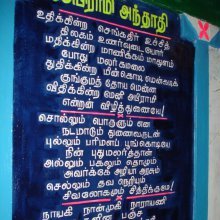Meni, Mēṇī, Meṇī, Mēṉi: 7 definitions
Introduction:
Meni means something in Hinduism, Sanskrit, Marathi, biology, Tamil. If you want to know the exact meaning, history, etymology or English translation of this term then check out the descriptions on this page. Add your comment or reference to a book if you want to contribute to this summary article.
Images (photo gallery)
Biology (plants and animals)
Source: Google Books: CRC World Dictionary (Regional names)1) Meni in Central African Republic is the name of a plant defined with Lophira alata in various botanical sources. This page contains potential references in Ayurveda, modern medicine, and other folk traditions or local practices It has the synonym Lophira tholloni Tiegh. (among others).
2) Meni in India is also identified with Acalypha indica It has the synonym Ricinocarpus baillonianus (Müll.Arg.) Kuntze (etc.).
Example references for further research on medicinal uses or toxicity (see latin names for full list):
· Flora de Filipinas (1837)
· Flora of Thailand (2005)
· Taiwania (1991)
· Pakistan Journal of Pharmaceutical Sciences (2010)
· Botanische Jahrbücher für Systematik, Pflanzengeschichte und Pflanzengeographie (1894)
· Fl. Carol. (1788)
If you are looking for specific details regarding Meni, for example chemical composition, diet and recipes, side effects, health benefits, pregnancy safety, extract dosage, have a look at these references.

This sections includes definitions from the five kingdoms of living things: Animals, Plants, Fungi, Protists and Monera. It will include both the official binomial nomenclature (scientific names usually in Latin) as well as regional spellings and variants.
Languages of India and abroad
Marathi-English dictionary
Source: DDSA: The Molesworth Marathi and English Dictionarymēṇī (मेणी).—f Oily soot, smut, or dirt. 2 Clottedness of hair.
Marathi is an Indo-European language having over 70 million native speakers people in (predominantly) Maharashtra India. Marathi, like many other Indo-Aryan languages, evolved from early forms of Prakrit, which itself is a subset of Sanskrit, one of the most ancient languages of the world.
Sanskrit dictionary
Source: Cologne Digital Sanskrit Dictionaries: Cappeller Sanskrit-English DictionaryMeni (मेनि).—[feminine] weapon, thrust, punishment, vengeance, anger, wrath.
Source: Cologne Digital Sanskrit Dictionaries: Monier-Williams Sanskrit-English Dictionary1) Meni (मेनि):—f. (√mī) a missile weapon, thunderbolt, [Ṛg-veda; Atharva-veda; Brāhmaṇa] (others ‘wrath’, ‘vengeance’, ‘punishment’)
2) speech (= vāc), [Naighaṇṭuka, commented on by Yāska i, 11] ([varia lectio] for menā).
[Sanskrit to German]
Sanskrit, also spelled संस्कृतम् (saṃskṛtam), is an ancient language of India commonly seen as the grandmother of the Indo-European language family (even English!). Closely allied with Prakrit and Pali, Sanskrit is more exhaustive in both grammar and terms and has the most extensive collection of literature in the world, greatly surpassing its sister-languages Greek and Latin.
Kannada-English dictionary
Source: Alar: Kannada-English corpusMēṇi (ಮೇಣಿ):—[noun] = ಮೇಟಿ [meti].
Kannada is a Dravidian language (as opposed to the Indo-European language family) mainly spoken in the southwestern region of India.
See also (Relevant definitions)
Starts with (+4): Meni Modashi, Meni oil tree, Meniccampa, Menigono, Menihalu, Menikulai, Menila, Menilar, Meniminukki, Menina, Meningolo, Menipalu, Menippon, Menir, Meniran, Meniran besar, Meniran kebo, Meniran sapi, Meniran utan, Menisperme du canada.
Ends with (+29): Ameni, Antakameni, Arumeni, Ayinmeni, Cailameni, Cakalattirumeni, Canakkimeni, Cekamurukameni, Centalalmeni, Centanalmeni, Ceppu-tirumeni, Cilameni, Cupameni, Eluntarulun-tirumeni, Hameni, Hau meni, Himmeni, Intiraimeni, Kanti-atikameni, Karumeni.
Full-text (+29): Pancameni, Yajnameni, Meniccampa, Kuppai-meni, Kuppai meni, Hau meni, Meni Modashi, Cilameni, Karaniya-menikal, Punalan, Kanti-atikameni, Meni oil tree, Oli-vilankumeni, Vaniccimeni, Tantalmeni, Mayavanmeni, Tirumeniyalaki, Karumeni, Menippon, Ivakkan.
Relevant text
Search found 4 books and stories containing Meni, Mēṇī, Meṇī, Mēṉi, Mēṇi; (plurals include: Menis, Mēṇīs, Meṇīs, Mēṉis, Mēṇis). You can also click to the full overview containing English textual excerpts. Below are direct links for the most relevant articles:
Rig Veda (translation and commentary) (by H. H. Wilson)
Rig Veda 10.27.11 < [Sukta 27]
Tiruvaymoli (Thiruvaimozhi): English translation (by S. Satyamurthi Ayyangar)
Pasuram 4.7.4 < [Section 7 - Seventh Tiruvaymoli (Cilam illac ciriyan)]
Pasuram 2.8.11 < [Section 8 - Eighth Tiruvaymoli (Anaivatu Aravu-anaimel)]
Pasuram 8.10.10 < [Section 10 - Tenth Tiruvaymoli (Netumarku atimai)]
The Religion and Philosophy of Tevaram (Thevaram) (by M. A. Dorai Rangaswamy)
Chapter 4.6 - (n) Symbology of Ash < [Volume 2 - Nampi Arurar and Mythology]
Chapter 4.6 - (l) Shiva’s ornamentation < [Volume 2 - Nampi Arurar and Mythology]
Chapter 2 - The Hymns, their Compilation and their Name < [Volume 1 - Nampi Arurar’s Tevaram (his life and age)]
The Gods of the Egyptians Vol 1 (by E. A. Wallis Budge)
Version B < [Chapter VIII - The History Of The Creation Of The Gods And Of The World]
